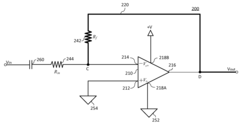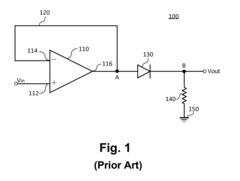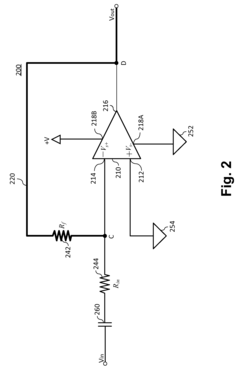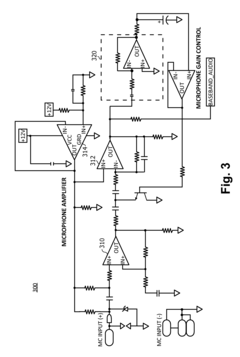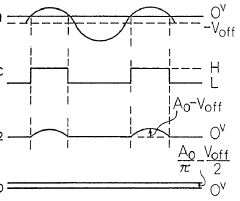Best Practices for Optimizing Half Wave Rectifier Output
JUL 15, 20259 MIN READ
Generate Your Research Report Instantly with AI Agent
Patsnap Eureka helps you evaluate technical feasibility & market potential.
Half Wave Rectifier Background and Objectives
Half wave rectification has been a fundamental technique in electrical engineering since the early days of electronics. This process, which converts alternating current (AC) to pulsating direct current (DC), has played a crucial role in the development of power supplies and signal processing circuits. The evolution of half wave rectifiers can be traced back to the invention of vacuum tube diodes in the early 20th century, which paved the way for more efficient and compact semiconductor diodes.
The primary objective of optimizing half wave rectifier output is to improve the quality and efficiency of the rectified signal. This involves minimizing ripple, reducing power loss, and enhancing overall system performance. As technology has advanced, the focus has shifted from basic functionality to achieving higher levels of efficiency and reliability in various applications, ranging from small-scale consumer electronics to large industrial power systems.
The technological trajectory of half wave rectifiers has been closely tied to advancements in semiconductor materials and circuit design techniques. The transition from vacuum tubes to solid-state devices marked a significant milestone, enabling smaller, more efficient, and more reliable rectifier circuits. Subsequent developments in silicon and other semiconductor materials have further improved the performance characteristics of diodes used in half wave rectification.
In recent years, the push for energy efficiency and miniaturization has driven research into novel materials and circuit topologies for half wave rectifiers. The integration of advanced control systems and the application of digital signal processing techniques have opened up new possibilities for optimizing rectifier performance. Additionally, the growing demand for high-frequency applications in telecommunications and power electronics has spurred innovation in fast-recovery diodes and specialized rectifier designs.
The optimization of half wave rectifier output is not only a technical challenge but also an economic imperative. Improved efficiency translates to reduced energy consumption, lower operating costs, and extended component lifespans. As global energy demands continue to rise, the importance of efficient power conversion technologies, including optimized half wave rectifiers, becomes increasingly significant in addressing sustainability concerns and meeting regulatory requirements.
Looking ahead, the field of half wave rectification is poised for further advancements. Emerging technologies such as wide-bandgap semiconductors and nanotechnology-based materials promise to push the boundaries of rectifier performance. The integration of half wave rectifiers with smart grid systems and renewable energy sources presents new challenges and opportunities for optimization, driving ongoing research and development efforts in this critical area of electrical engineering.
The primary objective of optimizing half wave rectifier output is to improve the quality and efficiency of the rectified signal. This involves minimizing ripple, reducing power loss, and enhancing overall system performance. As technology has advanced, the focus has shifted from basic functionality to achieving higher levels of efficiency and reliability in various applications, ranging from small-scale consumer electronics to large industrial power systems.
The technological trajectory of half wave rectifiers has been closely tied to advancements in semiconductor materials and circuit design techniques. The transition from vacuum tubes to solid-state devices marked a significant milestone, enabling smaller, more efficient, and more reliable rectifier circuits. Subsequent developments in silicon and other semiconductor materials have further improved the performance characteristics of diodes used in half wave rectification.
In recent years, the push for energy efficiency and miniaturization has driven research into novel materials and circuit topologies for half wave rectifiers. The integration of advanced control systems and the application of digital signal processing techniques have opened up new possibilities for optimizing rectifier performance. Additionally, the growing demand for high-frequency applications in telecommunications and power electronics has spurred innovation in fast-recovery diodes and specialized rectifier designs.
The optimization of half wave rectifier output is not only a technical challenge but also an economic imperative. Improved efficiency translates to reduced energy consumption, lower operating costs, and extended component lifespans. As global energy demands continue to rise, the importance of efficient power conversion technologies, including optimized half wave rectifiers, becomes increasingly significant in addressing sustainability concerns and meeting regulatory requirements.
Looking ahead, the field of half wave rectification is poised for further advancements. Emerging technologies such as wide-bandgap semiconductors and nanotechnology-based materials promise to push the boundaries of rectifier performance. The integration of half wave rectifiers with smart grid systems and renewable energy sources presents new challenges and opportunities for optimization, driving ongoing research and development efforts in this critical area of electrical engineering.
Market Demand Analysis for Rectifier Applications
The market demand for rectifier applications has been steadily growing, driven by the increasing need for power conversion and management across various industries. Half-wave rectifiers, as a fundamental component in power electronics, play a crucial role in converting alternating current (AC) to direct current (DC). The demand for optimized half-wave rectifier output is particularly strong in sectors such as consumer electronics, automotive, industrial automation, and renewable energy.
In the consumer electronics sector, the proliferation of portable devices and smart home appliances has created a significant market for efficient power conversion solutions. Half-wave rectifiers are extensively used in chargers, adapters, and power supplies for smartphones, laptops, and other personal electronic devices. The demand for compact, energy-efficient, and fast-charging solutions has pushed manufacturers to focus on optimizing rectifier performance.
The automotive industry represents another major market for rectifier applications. With the rapid growth of electric vehicles (EVs) and hybrid electric vehicles (HEVs), there is an increasing need for high-performance rectifiers in battery management systems, on-board chargers, and power distribution units. The optimization of half-wave rectifier output is critical for improving overall vehicle efficiency and extending battery life.
Industrial automation and control systems also contribute significantly to the market demand for rectifier applications. Factory automation, robotics, and process control equipment rely heavily on stable and efficient power conversion. Optimized half-wave rectifiers are essential components in motor drives, programmable logic controllers (PLCs), and other industrial electronic devices.
The renewable energy sector, particularly solar and wind power generation, has emerged as a rapidly growing market for rectifier applications. Solar inverters and wind turbine converters require high-efficiency rectifiers to maximize energy harvesting and conversion. As the global push for clean energy intensifies, the demand for optimized rectifier solutions in this sector is expected to continue its upward trajectory.
Telecommunications infrastructure represents another substantial market for rectifier applications. The ongoing expansion of 5G networks and data centers necessitates reliable and efficient power conversion solutions. Half-wave rectifiers are integral components in power supplies for base stations, servers, and network equipment.
The market demand for optimized half-wave rectifier output is also influenced by regulatory standards and energy efficiency requirements. Governments and international organizations are implementing stricter regulations on power consumption and electromagnetic interference (EMI), driving the need for more sophisticated rectifier designs that can meet these standards while delivering improved performance.
As the Internet of Things (IoT) continues to expand, the demand for low-power rectifier solutions for sensor nodes and edge devices is growing. This emerging market segment requires highly efficient and miniaturized rectifier designs to enable long battery life and energy harvesting capabilities in IoT applications.
In the consumer electronics sector, the proliferation of portable devices and smart home appliances has created a significant market for efficient power conversion solutions. Half-wave rectifiers are extensively used in chargers, adapters, and power supplies for smartphones, laptops, and other personal electronic devices. The demand for compact, energy-efficient, and fast-charging solutions has pushed manufacturers to focus on optimizing rectifier performance.
The automotive industry represents another major market for rectifier applications. With the rapid growth of electric vehicles (EVs) and hybrid electric vehicles (HEVs), there is an increasing need for high-performance rectifiers in battery management systems, on-board chargers, and power distribution units. The optimization of half-wave rectifier output is critical for improving overall vehicle efficiency and extending battery life.
Industrial automation and control systems also contribute significantly to the market demand for rectifier applications. Factory automation, robotics, and process control equipment rely heavily on stable and efficient power conversion. Optimized half-wave rectifiers are essential components in motor drives, programmable logic controllers (PLCs), and other industrial electronic devices.
The renewable energy sector, particularly solar and wind power generation, has emerged as a rapidly growing market for rectifier applications. Solar inverters and wind turbine converters require high-efficiency rectifiers to maximize energy harvesting and conversion. As the global push for clean energy intensifies, the demand for optimized rectifier solutions in this sector is expected to continue its upward trajectory.
Telecommunications infrastructure represents another substantial market for rectifier applications. The ongoing expansion of 5G networks and data centers necessitates reliable and efficient power conversion solutions. Half-wave rectifiers are integral components in power supplies for base stations, servers, and network equipment.
The market demand for optimized half-wave rectifier output is also influenced by regulatory standards and energy efficiency requirements. Governments and international organizations are implementing stricter regulations on power consumption and electromagnetic interference (EMI), driving the need for more sophisticated rectifier designs that can meet these standards while delivering improved performance.
As the Internet of Things (IoT) continues to expand, the demand for low-power rectifier solutions for sensor nodes and edge devices is growing. This emerging market segment requires highly efficient and miniaturized rectifier designs to enable long battery life and energy harvesting capabilities in IoT applications.
Current Challenges in Half Wave Rectification
Half wave rectification, while a fundamental technique in power electronics, faces several challenges that limit its efficiency and applicability in modern systems. One of the primary issues is the inherent inefficiency of the process, as it only utilizes half of the input waveform. This results in a significant amount of energy loss, particularly in high-power applications where every percentage of efficiency matters.
Another challenge is the high ripple content in the output voltage. The pulsating nature of the rectified waveform leads to a substantial AC component superimposed on the DC output. This ripple can cause unwanted noise and interference in sensitive electronic circuits, necessitating additional filtering stages that add complexity and cost to the overall system.
The non-linear behavior of diodes used in half wave rectifiers presents another set of challenges. The forward voltage drop across the diode leads to power loss and reduces the overall efficiency of the rectification process. Additionally, the non-linear characteristics of diodes can introduce harmonic distortion, which is particularly problematic in applications requiring high signal purity.
Thermal management is a significant concern in half wave rectifier circuits, especially in high-power applications. The pulsating current flow through the rectifier diode results in concentrated heat generation, which can lead to reliability issues and reduced component lifespan if not properly addressed.
The poor utilization of transformer capacity is another challenge associated with half wave rectification. Since current flows through the transformer secondary winding in only one direction, the core material is not fully utilized, leading to inefficient use of the magnetic components and increased overall system size and cost.
Electromagnetic interference (EMI) generation is a persistent issue in half wave rectifier circuits. The abrupt current transitions during rectification can produce high-frequency harmonics, potentially causing electromagnetic compatibility problems with nearby electronic equipment.
Voltage regulation is also challenging in half wave rectifier systems. The output voltage tends to vary significantly with changes in load current or input voltage, necessitating complex regulation circuits to maintain a stable DC output. This challenge becomes more pronounced in applications requiring precise voltage control.
Finally, the limited power handling capability of half wave rectifiers restricts their use in high-power applications. The peak inverse voltage stress on the rectifier diode is twice the peak input voltage, requiring higher-rated components and potentially increasing costs.
Addressing these challenges requires innovative approaches in circuit design, component selection, and system integration. As power electronics continue to evolve, finding solutions to these issues remains crucial for improving the performance and applicability of half wave rectification in modern electronic systems.
Another challenge is the high ripple content in the output voltage. The pulsating nature of the rectified waveform leads to a substantial AC component superimposed on the DC output. This ripple can cause unwanted noise and interference in sensitive electronic circuits, necessitating additional filtering stages that add complexity and cost to the overall system.
The non-linear behavior of diodes used in half wave rectifiers presents another set of challenges. The forward voltage drop across the diode leads to power loss and reduces the overall efficiency of the rectification process. Additionally, the non-linear characteristics of diodes can introduce harmonic distortion, which is particularly problematic in applications requiring high signal purity.
Thermal management is a significant concern in half wave rectifier circuits, especially in high-power applications. The pulsating current flow through the rectifier diode results in concentrated heat generation, which can lead to reliability issues and reduced component lifespan if not properly addressed.
The poor utilization of transformer capacity is another challenge associated with half wave rectification. Since current flows through the transformer secondary winding in only one direction, the core material is not fully utilized, leading to inefficient use of the magnetic components and increased overall system size and cost.
Electromagnetic interference (EMI) generation is a persistent issue in half wave rectifier circuits. The abrupt current transitions during rectification can produce high-frequency harmonics, potentially causing electromagnetic compatibility problems with nearby electronic equipment.
Voltage regulation is also challenging in half wave rectifier systems. The output voltage tends to vary significantly with changes in load current or input voltage, necessitating complex regulation circuits to maintain a stable DC output. This challenge becomes more pronounced in applications requiring precise voltage control.
Finally, the limited power handling capability of half wave rectifiers restricts their use in high-power applications. The peak inverse voltage stress on the rectifier diode is twice the peak input voltage, requiring higher-rated components and potentially increasing costs.
Addressing these challenges requires innovative approaches in circuit design, component selection, and system integration. As power electronics continue to evolve, finding solutions to these issues remains crucial for improving the performance and applicability of half wave rectification in modern electronic systems.
Existing Optimization Techniques for Half Wave Rectifiers
01 Output voltage characteristics
Half-wave rectifiers produce a pulsating DC output voltage with only positive or negative half-cycles of the input AC waveform. This results in a lower average output voltage compared to full-wave rectifiers and higher ripple content. The output waveform consists of discrete pulses separated by zero-voltage periods.- Output characteristics of half-wave rectifiers: Half-wave rectifiers convert AC input into pulsating DC output by allowing current flow in only one direction during each cycle. The output waveform consists of positive half-cycles separated by zero-voltage periods, resulting in a lower average output voltage compared to full-wave rectifiers. This pulsating nature of the output requires additional filtering for many applications.
- Filtering and smoothing techniques: To improve the quality of the half-wave rectifier output, various filtering and smoothing techniques are employed. These may include capacitor filters, inductor-capacitor (LC) filters, or more complex arrangements. The goal is to reduce ripple and provide a more stable DC output voltage, which is crucial for many electronic applications.
- Efficiency and power factor considerations: Half-wave rectifiers are generally less efficient than full-wave rectifiers due to their utilization of only half of the AC cycle. This results in a lower power factor and increased harmonic distortion. Various circuit designs and control strategies are implemented to improve efficiency and power factor, particularly in high-power applications.
- Applications in power supplies and charging circuits: Despite their limitations, half-wave rectifiers find use in specific applications such as low-power supplies, battery charging circuits, and some motor control systems. Their simplicity and lower component count can be advantageous in certain scenarios, particularly where cost or space constraints are significant factors.
- Voltage regulation and protection circuits: To maintain a stable output voltage and protect against overload or short-circuit conditions, half-wave rectifier circuits often incorporate voltage regulation and protection mechanisms. These may include zener diodes, voltage regulator ICs, or more sophisticated feedback control systems to ensure reliable operation across varying load conditions.
02 Filtering and smoothing techniques
To improve the quality of the half-wave rectifier output, various filtering and smoothing techniques are employed. These may include capacitor filters, inductor-capacitor (LC) filters, or more complex filter networks. Such techniques help reduce ripple and provide a more stable DC output voltage for practical applications.Expand Specific Solutions03 Efficiency and power factor considerations
Half-wave rectifiers generally have lower efficiency and power factor compared to full-wave rectifiers. This is due to the utilization of only one half-cycle of the input waveform. Various circuit modifications and control strategies can be implemented to improve efficiency and power factor, such as active power factor correction techniques.Expand Specific Solutions04 Applications in low-power devices
Despite their limitations, half-wave rectifiers find applications in various low-power devices and circuits. They are often used in simple power supplies, battery chargers, and signal detection circuits. In some cases, their simplicity and lower component count make them suitable for specific design requirements.Expand Specific Solutions05 Control and regulation techniques
Various control and regulation techniques can be applied to half-wave rectifier circuits to improve their performance. These may include voltage regulation, current limiting, and feedback control mechanisms. Such techniques help maintain a stable output voltage under varying load conditions and input voltage fluctuations.Expand Specific Solutions
Key Players in Power Electronics Industry
The market for optimizing half wave rectifier output is in a mature stage, with established players and well-understood technologies. The global power electronics market, which includes rectifiers, is projected to reach $40 billion by 2027. Technologically, half wave rectifiers are well-developed, but ongoing research focuses on improving efficiency and reducing power loss. Key players like Mitsubishi Electric, NEC, and Sanken Electric are driving innovation in this space, leveraging their expertise in semiconductor devices and power systems. Companies such as Semiconductor Energy Laboratory and Mixed-Signal Devices are exploring advanced materials and digital-assisted techniques to enhance rectifier performance, indicating a trend towards more sophisticated solutions in this mature technology area.
Sanken Electric Co., Ltd.
Technical Solution: Sanken Electric has developed innovative half-wave rectifier optimization techniques focusing on high-voltage applications and reliability. Their approach involves the use of proprietary high-voltage semiconductor materials and structures to create rectifiers with exceptional breakdown voltage characteristics[2]. Sanken has implemented advanced junction termination techniques, such as field plate structures and floating guard rings, to enhance voltage handling capability and reduce edge-related breakdown phenomena[4]. They have also developed unique packaging solutions that improve thermal dissipation and reduce parasitic inductances, enabling higher current handling capabilities[6]. Furthermore, Sanken's designs incorporate intelligent protection features, including overvoltage and overcurrent detection circuits, to enhance long-term reliability in harsh operating environments[8].
Strengths: High voltage handling, excellent reliability, improved thermal management, and built-in protection features. Weaknesses: Potentially higher costs for specialized materials and manufacturing processes.
Mitsubishi Electric Corp.
Technical Solution: Mitsubishi Electric has focused on optimizing half-wave rectifiers for high-power applications, particularly in industrial and renewable energy sectors. Their approach involves the use of advanced wide-bandgap semiconductors, such as silicon carbide (SiC), to create rectifiers with lower on-state resistance and faster switching capabilities[1]. Mitsubishi has developed sophisticated gate drive circuits that optimize switching behavior and reduce losses across a wide range of operating conditions[3]. They have implemented advanced thermal management solutions, including direct liquid cooling and novel heat spreader designs, to handle high power densities efficiently[5]. Additionally, Mitsubishi's designs incorporate intelligent monitoring and diagnostics features, such as real-time junction temperature estimation and predictive maintenance algorithms, to enhance system reliability and longevity[7].
Strengths: High power handling, excellent efficiency, advanced thermal management, and intelligent monitoring capabilities. Weaknesses: Higher initial costs due to advanced materials and sophisticated control systems.
Core Innovations in Rectifier Design
Ac to DC conversion circuit
PatentActiveUS20090080224A1
Innovation
- A diode-less half-wave rectifier circuit utilizing an operational amplifier with a capacitor and resistors in a negative feedback loop, allowing low-level signals to be converted to DC without clipping, thereby extending the dynamic range of rectification.
Half-wave rectifier circuit
PatentInactiveUS5579214A
Innovation
- The proposed half-wave rectifier circuit design includes a capacitor to remove DC components, a comparator with an operational amplifier and capacitor to accumulate offset voltage, and a switch circuit with high input impedance during the OFF state to eliminate the influence of offset voltage, ensuring accurate output voltage generation.
Efficiency Comparison of Rectifier Topologies
When comparing the efficiency of different rectifier topologies, it is essential to consider various factors that influence their performance. Half-wave rectifiers, full-wave rectifiers, and bridge rectifiers are the primary topologies used in power conversion applications. Each topology has its advantages and drawbacks in terms of efficiency, output quality, and component requirements.
Half-wave rectifiers, while simple in design, generally exhibit lower efficiency compared to other topologies. They utilize only one half of the AC cycle, resulting in a pulsating DC output with significant ripple. This topology requires less components but suffers from poor power utilization and higher harmonic content. The efficiency of half-wave rectifiers typically ranges from 40% to 50%, depending on the load characteristics and filtering techniques employed.
Full-wave rectifiers offer improved efficiency by utilizing both halves of the AC cycle. This topology can be implemented using a center-tapped transformer or four diodes in a bridge configuration. Full-wave rectifiers provide a smoother DC output with reduced ripple, resulting in efficiencies ranging from 60% to 75%. The increased efficiency is attributed to better utilization of the input waveform and reduced filtering requirements.
Bridge rectifiers, a type of full-wave rectifier, are widely used in power supply applications due to their high efficiency and versatility. This topology employs four diodes arranged in a bridge configuration, eliminating the need for a center-tapped transformer. Bridge rectifiers typically achieve efficiencies between 70% and 85%, making them the preferred choice for many applications requiring higher power output and improved efficiency.
When comparing these topologies, it is crucial to consider factors such as voltage drop across diodes, transformer requirements, and filtering needs. Half-wave rectifiers suffer from higher voltage drops and require larger filtering components, while full-wave and bridge rectifiers offer better performance in these aspects. Additionally, the choice of rectifier topology impacts the overall size, cost, and complexity of the power supply system.
In applications where efficiency is paramount, such as high-power industrial systems or renewable energy converters, more advanced rectifier topologies like synchronous rectifiers or active rectifiers may be employed. These designs utilize controlled switching devices, such as MOSFETs, to reduce conduction losses and achieve efficiencies exceeding 90%. However, the increased complexity and cost of these advanced topologies must be weighed against the efficiency gains in specific applications.
Half-wave rectifiers, while simple in design, generally exhibit lower efficiency compared to other topologies. They utilize only one half of the AC cycle, resulting in a pulsating DC output with significant ripple. This topology requires less components but suffers from poor power utilization and higher harmonic content. The efficiency of half-wave rectifiers typically ranges from 40% to 50%, depending on the load characteristics and filtering techniques employed.
Full-wave rectifiers offer improved efficiency by utilizing both halves of the AC cycle. This topology can be implemented using a center-tapped transformer or four diodes in a bridge configuration. Full-wave rectifiers provide a smoother DC output with reduced ripple, resulting in efficiencies ranging from 60% to 75%. The increased efficiency is attributed to better utilization of the input waveform and reduced filtering requirements.
Bridge rectifiers, a type of full-wave rectifier, are widely used in power supply applications due to their high efficiency and versatility. This topology employs four diodes arranged in a bridge configuration, eliminating the need for a center-tapped transformer. Bridge rectifiers typically achieve efficiencies between 70% and 85%, making them the preferred choice for many applications requiring higher power output and improved efficiency.
When comparing these topologies, it is crucial to consider factors such as voltage drop across diodes, transformer requirements, and filtering needs. Half-wave rectifiers suffer from higher voltage drops and require larger filtering components, while full-wave and bridge rectifiers offer better performance in these aspects. Additionally, the choice of rectifier topology impacts the overall size, cost, and complexity of the power supply system.
In applications where efficiency is paramount, such as high-power industrial systems or renewable energy converters, more advanced rectifier topologies like synchronous rectifiers or active rectifiers may be employed. These designs utilize controlled switching devices, such as MOSFETs, to reduce conduction losses and achieve efficiencies exceeding 90%. However, the increased complexity and cost of these advanced topologies must be weighed against the efficiency gains in specific applications.
Environmental Impact of Rectifier Technologies
The environmental impact of rectifier technologies, particularly in the context of half-wave rectifiers, is a crucial consideration in the broader landscape of power electronics and energy efficiency. As the demand for electronic devices continues to grow, the cumulative effect of rectifier technologies on the environment becomes increasingly significant.
Half-wave rectifiers, while simple in design, are generally less efficient than their full-wave counterparts. This lower efficiency translates to increased power losses, which in turn leads to higher energy consumption and, consequently, a larger carbon footprint. The environmental implications of this inefficiency are twofold: increased demand for electricity generation and greater heat dissipation.
The increased electricity demand associated with less efficient rectifiers contributes to higher greenhouse gas emissions, particularly in regions where fossil fuels remain a significant part of the energy mix. This impact is further exacerbated by the sheer number of electronic devices in use globally, each containing rectifier circuits.
Heat dissipation from rectifiers, especially in high-power applications, necessitates additional cooling mechanisms. These cooling systems often require materials with high environmental costs, such as metals and plastics, and may consume additional energy themselves. The production and disposal of these cooling components add to the overall environmental burden of rectifier technologies.
Furthermore, the materials used in rectifier construction, including semiconductors and various metals, have their own environmental considerations. The mining and processing of these materials can lead to habitat destruction, water pollution, and energy-intensive manufacturing processes. Additionally, the disposal of electronic waste containing rectifier components poses significant environmental challenges, including the potential release of toxic substances into ecosystems.
However, ongoing research and development in rectifier technologies are addressing these environmental concerns. Advances in semiconductor materials, such as wide-bandgap semiconductors like silicon carbide and gallium nitride, are improving rectifier efficiency and reducing power losses. These improvements not only decrease energy consumption but also minimize the need for extensive cooling systems, thereby reducing the overall environmental impact.
Moreover, the push towards miniaturization in electronics is leading to more compact and efficient rectifier designs. This trend not only reduces material usage but also contributes to lower transportation-related emissions in the supply chain. Additionally, efforts to improve the recyclability of electronic components, including rectifiers, are gaining traction, potentially mitigating some of the end-of-life environmental impacts.
In conclusion, while rectifier technologies, including half-wave rectifiers, have historically posed environmental challenges, ongoing technological advancements and a growing focus on sustainability are driving improvements. The future of rectifier technologies lies in balancing performance with environmental responsibility, a goal that aligns with broader efforts to create more sustainable electronic ecosystems.
Half-wave rectifiers, while simple in design, are generally less efficient than their full-wave counterparts. This lower efficiency translates to increased power losses, which in turn leads to higher energy consumption and, consequently, a larger carbon footprint. The environmental implications of this inefficiency are twofold: increased demand for electricity generation and greater heat dissipation.
The increased electricity demand associated with less efficient rectifiers contributes to higher greenhouse gas emissions, particularly in regions where fossil fuels remain a significant part of the energy mix. This impact is further exacerbated by the sheer number of electronic devices in use globally, each containing rectifier circuits.
Heat dissipation from rectifiers, especially in high-power applications, necessitates additional cooling mechanisms. These cooling systems often require materials with high environmental costs, such as metals and plastics, and may consume additional energy themselves. The production and disposal of these cooling components add to the overall environmental burden of rectifier technologies.
Furthermore, the materials used in rectifier construction, including semiconductors and various metals, have their own environmental considerations. The mining and processing of these materials can lead to habitat destruction, water pollution, and energy-intensive manufacturing processes. Additionally, the disposal of electronic waste containing rectifier components poses significant environmental challenges, including the potential release of toxic substances into ecosystems.
However, ongoing research and development in rectifier technologies are addressing these environmental concerns. Advances in semiconductor materials, such as wide-bandgap semiconductors like silicon carbide and gallium nitride, are improving rectifier efficiency and reducing power losses. These improvements not only decrease energy consumption but also minimize the need for extensive cooling systems, thereby reducing the overall environmental impact.
Moreover, the push towards miniaturization in electronics is leading to more compact and efficient rectifier designs. This trend not only reduces material usage but also contributes to lower transportation-related emissions in the supply chain. Additionally, efforts to improve the recyclability of electronic components, including rectifiers, are gaining traction, potentially mitigating some of the end-of-life environmental impacts.
In conclusion, while rectifier technologies, including half-wave rectifiers, have historically posed environmental challenges, ongoing technological advancements and a growing focus on sustainability are driving improvements. The future of rectifier technologies lies in balancing performance with environmental responsibility, a goal that aligns with broader efforts to create more sustainable electronic ecosystems.
Unlock deeper insights with Patsnap Eureka Quick Research — get a full tech report to explore trends and direct your research. Try now!
Generate Your Research Report Instantly with AI Agent
Supercharge your innovation with Patsnap Eureka AI Agent Platform!
